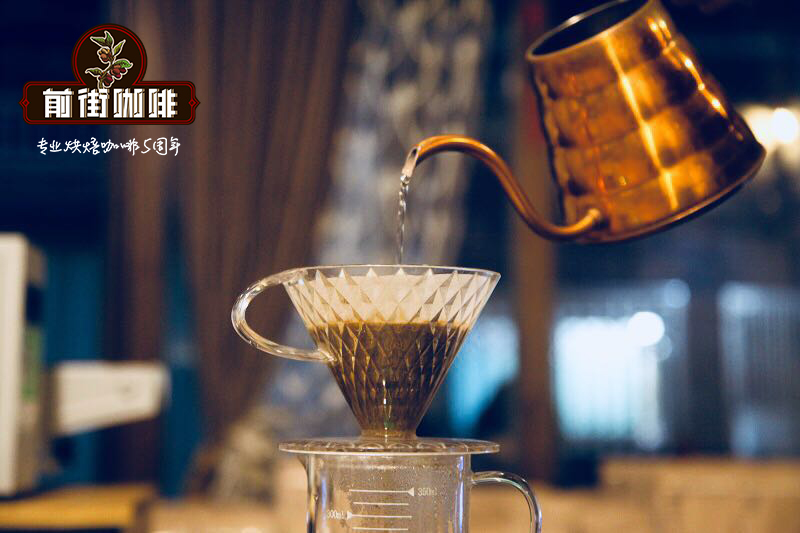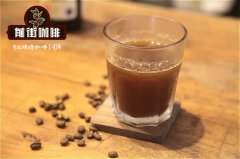Costa Rican Carnett Manor Coffee Bean hand-brewing parameters Costa Rican Honey treatment Story

Professional coffee knowledge exchange more coffee bean information please follow the coffee workshop (Wechat official account cafe_style)
COSTA RICA CANET Yellow Catuai
Huang Cadura, Carnett Manor, Costa Rica
| 01 | production area profile |
Carnett Manor Canet is located at the highest altitude where Tarrazu Tarazu Coffee is grown in Costa Rica. Carnett is the name of a small farm in this field. Finca Canet is a small 5-hectare estate in the town of San Marcos in Tarrazu, owned by three brothers, the Robles brothers Leo and Elianand Melvin, who have worked together for more than 10 years and share a small water treatment plant (Beneficio).
More than three generations of the Montero family have produced Costa Rican coffee in the charming mountains of Tarrazu. Today, Carlos and his whole family are involved in the farm in Cane, the name of a small farm called Don Eli. Carlos and his family are deeply involved in Dowie Coffee Farm and miniature mills. With the support of his family, Carlos managed farming and milling. He is in different small farms, but also in the process of picking dates and separation.
The locals choose well-ripe cherries. This area is the most densely planted area of Costa Rican fruit, the main manor is to grow passion fruit, the amount of coffee is quite rare, there is only one specific area to grow coffee, take special care, only pick ripe red cherry fruit. The unique variety in the manor: yellow Catuai.
Yellow Catuai; Catuai Amarillo, a hybrid of Mundo Novo and Kaddura, was first bred by the Brazilian Institute of Agricultural Research (Instituto Agronomico de Campinas) in 1949. Huangkaduai, like Red Kaduai (Red Catuai,Catuai Rojo), has extremely high disease resistance and is suitable for planting in high-altitude, windy areas. Both Catuai also have a delicate and clean sour taste.
Through the adjustment of the machine, honey-treated coffee is produced (depending on the degree of honey treatment). Canet is located at the highest altitude where Tarrazu coffee is grown in Costa Rica. However, most of the coffee beans in this area are treated with red honey, black honey and yellow honey. This area is the most densely planted area of Costa Rican fruit, the main manor is to grow passion fruit, the amount of coffee is very rare, only a specific area to grow coffee, take special care, only pick ripe red cherry fruit.
They launched a series of musicians (Musican Series) products, a total of three beans, using different raw bean processing technology, highlighting different unique features.
Costa Rican Coffee Carnett Manor Bach Mozart
Country: Costa Rica
Area: Tarrazu Tazhu
Variety: catuai
Manor: Carnett
Technology: raisin treatment
Altitude: 1800-1900 m
Grade: SHB
The treatment process is [double fermented honey treatment], which is to cool the coffee fruit into a raisin state (the fruit that makes raisins must be ripe fruit, preferably shade dried. The most famous raisins made from seedless grapes in Turpan, Xinjiang, China. Turpan has a hot and dry climate. There are many wall holes in the four walls of the brick dry room, with wooden sticks in the middle. The ripe seedless grapes will be put on. After hot air blowing, you will soon get high-quality raisins), and then peel honey to deal with fermentation, the flavor of fermentation will be more intense. And pectin preservation is higher than other honey treatments, claiming to be 100% pectin honey treatment really has the flavor of raisins.
This is a very sweet treatment, with the taste of white wine and balanced acidity, the flavor of fermentation will be more intense, and the preservation of pectin is higher than other honey treatments, a bit like "expensive rotten wine" sweet wine, honey, preserved apricot, raisins, peaches and other flavors.
Costa Rican Coffee Carnett Manor Beethoven
Country: Costa Rica
Area: Tarrazu Tazhu
Variety: catuai
Manor: Carnett
Process: washing treatment
Altitude: 1800-1900 m
Grade: SHB
Beethoven is a lively and beautiful type with a strong aroma of sour flowers and fruits, especially classic with a clear and long acidity like wind chimes. The aromas of flowers and fruit fill the mouth, with sweet aromas of honey, caramel, jasmine, fresh cherries, blackberries and limes. This is a great coffee with a description of sweet and colorful fruits, strawberry, apple, lemon, grape and citrus, and unforgettable taste of honey and toffee. Silky, creamy and mellow, such as the lingering finish of top Indian Darjeeling black tea.
02 | Baking analysis
Take Beethoven as an example
Yangjia 800N, raw bean 550g, specific operation:
The furnace temperature is 200 degrees Celsius, the throttle is set up and steamed for 1 minute, the firepower is adjusted to 160C, the throttle remains unchanged, the furnace temperature is adjusted to 165C, the temperature is reduced to 140C, the temperature is baked to 5oC 30 ", the temperature is 155.1 degrees, the bean surface turns yellow, the smell of grass disappears completely, the dehydration is completed, and the throttle remains unchanged.
In the 9th minute, ugly wrinkles and black markings appear on the bean surface, and the smell of toast obviously changes to the smell of coffee, which can be defined as a prelude to an explosion. At this time, listen clearly to the sound of an explosion point, to 8: 04 "start an explosion, adjust the firepower to 80 degrees, the throttle is fully open 5 degrees (the fire power should be very careful, not so small as to be free of cracking sound) 40 degrees, and the fire drops to 194.5 degrees when the heat drops into the pan.
Analysis of Costa Rican coffee brewing
[Costa Rican hand-siphon cooking demonstration]
First of all, we need to understand the characteristics of Mozart beans.
Mozart's cup test flavor is as follows: sweet and colorful fruits (strawberry, apple, grape, citrus) unforgettable taste of honey and toffee, delicate and mellow as silky cream (such as the long finish of Darjeeling black tea)
Therefore, our main extraction targets are the sweet and sour flavor and fermented flavor in the front and middle, as well as the mellow finish.
Costa Rica's SHB beans are relatively high above sea level, hard, and have excellent sweet and sour texture (that is, they are more resistant to extraction), so even if they are moderately baked, we can extract them with water of 91 degrees, rather than worrying too much about overextraction and bitterness.
Comparison of original cooking record table
Costa Rican hand impact parameters
Degree of grinding: BG mill: hand-made 4e VS siphon 5D
Since this bean has just been raised for 10 days, it has almost reached the best flavor period; the exhaust reaction has entered the tail stage; the filtration speed of hand filter cup V60 is faster, to sum up, the hand grinding degree needs medium fineness, while the siphon grinding degree is slightly thicker than hand grinding.
Water temperature: 90 degrees VS 91 degrees
Hand extraction time is long, so the water temperature of 90 degrees is suitable, you can extract more complete and rich flavor substances without over-extraction.
The siphon extraction time is short, so the relative water temperature is 91 degrees, which can balance the extraction rate.
Powder / water ratio: hand 1:15 VS siphon 1:12
The extraction process of hand flushing is a cooling extraction process, the extraction temperature of the latter stage is lower than that of the front stage, and it is relatively difficult to overextract. Increasing the ratio of powder to water can improve the sense of hierarchy and richness.
Siphon extraction is an immersion extraction process, the lower the extraction efficiency (concentration problem), but can maintain a high water temperature, so that a certain section of the flavor is relatively complete and prominent. The powder water is relatively small in order to highlight the sour and sweet flavor of the front and middle section and avoid the woody flavor of the back section extracted too early.
Specific siphon cooking techniques:
Use the post-powder method, that is, first boil the water to the pot, and then add powder to stir.
The first step: boil until the fisheye bubble is formed, insert the pot tightly; when the hot water rises to the pot, measure the water temperature, 91 degrees. Adjust the firepower until the water column is stable and there are no bubbles in the upper pot. Then cross the cross and gently press the powder to wet completely.
The second step: steam for 38 seconds, observe the bubble state of the powder layer, stir in a circle for the first time, and stir three times.
Step 3: boil to 52 seconds, turn off the engine, wait for the siphon, and the coffee flows back to the pot.
END
Important Notice :
前街咖啡 FrontStreet Coffee has moved to new addredd:
FrontStreet Coffee Address: 315,Donghua East Road,GuangZhou
Tel:020 38364473
- Prev

Coffee brewing suggestion of Gable Manor in Tara Zhu, Costa Rica _ description of Coffee Bean Flavor of Gable Manor
Professional coffee knowledge exchange more coffee bean information please follow the coffee workshop (Wechat official account cafe_style) Costa Rica Coffee Gable Manor Black Honey processing Spectrum: longan Sweet Honey fragrance smooth mellow Origin: Costa Rican Coffee Tara Pearl Gabor Manor Diamond Hill processing Plant characteristics: Costa Rica is the birthplace of honey treatment, but high difficulty and high quality
- Next

Coffee hand-made suggestion in Carmen Manor, Costa Rica. Flavor characteristics of Costa Rican yellow honey coffee
Professional coffee knowledge exchange more coffee bean information please follow Coffee Workshop (Wechat cafe_style) COSTA RICA AGUERO CEDRAL YELLOW HONEY CATUAI ROJO Cedar Manor in Costa Rica Yellow Honey treatment Kaduai Red berry Coffee Origin: Santa Maria, Dota region of Tarrazu, Costa Rica. Bean seed: Red C
Related
- Detailed explanation of Jadeite planting Land in Panamanian Jadeite Manor introduction to the grading system of Jadeite competitive bidding, Red bid, Green bid and Rose Summer
- Story of Coffee planting in Brenka region of Costa Rica Stonehenge Manor anaerobic heavy honey treatment of flavor mouth
- What's on the barrel of Blue Mountain Coffee beans?
- Can American coffee also pull flowers? How to use hot American style to pull out a good-looking pattern?
- Can you make a cold extract with coffee beans? What is the right proportion for cold-extracted coffee formula?
- Indonesian PWN Gold Mandrine Coffee Origin Features Flavor How to Chong? Mandolin coffee is American.
- A brief introduction to the flavor characteristics of Brazilian yellow bourbon coffee beans
- What is the effect of different water quality on the flavor of cold-extracted coffee? What kind of water is best for brewing coffee?
- Why do you think of Rose Summer whenever you mention Panamanian coffee?
- Introduction to the characteristics of authentic blue mountain coffee bean producing areas? What is the CIB Coffee Authority in Jamaica?

